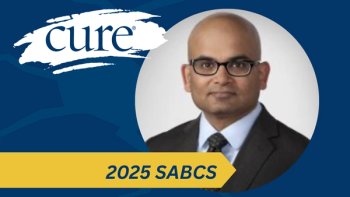
Novel Agents May Lead to a Chemo-Free Future for Patients With Mantle Cell Lymphoma
One expert discusses the current treatment options for patients with mantle cell lymphoma as well as the potential shift away from chemotherapy in the future.
Unlike other types of lymphoma, there may be a clear shift away from chemotherapy in the treatment paradigm of mantle cell lymphoma (MCL), according to Dr. Simon Rule.
“Ten years from now, I believe the field will be completely chemotherapy-free,” he said in an interview with CURE’s sister publication OncLive, adding that all newly diagnosed patients may be treated with emerging novel agents such as a B cell lymphoma 2 (BCL-2) inhibitor, Bruton tyrosine kinase (BTK) inhibitor, or potentially with an antibody.
“There's a general consensus in MCL, unlike other lymphomas, that there's going to be a clear shift towards a chemotherapy-free treatment paradigm, particularly when we see emerging data with combinations like Imbruvica (ibrutinib) and Venclexta (venetoclax), which appears to be the most exciting,” added Rule, who is a professor of hematology at Plymouth University Medical School.
Current Treatment
Young patients who are newly diagnosed with MCL receive a high-dose cytarabine-based regimen usually followed by an autologous stem cell transplant (ASCT). Meanwhile, patients who are older than 65 years are generally given a bendamustine- or CHOP (cyclophosphamide, doxorubicin hydrochloride, vincristine sulfate and prednisone)-based therapy. In addition, the use of Rituxan (rituximab) maintenance therapy depends on age and physician preference.
In the second-line setting, BTK inhibitors used as a single agent are currently the standard of care.
Beyond that, things can get tricky: “Beyond the second-line setting, however, you're getting into several potential treatments,” Rule said. “Generally, however, we are not curing patients, with the exception of very young fit patients where a stem cell transplant is potentially curative. With that exception, it's all about how you sequence your therapies and how you maximize the quality and duration of life in these patients.”
Under Investigation
In one study, Rule explained, the combination use of Imbruvica and Venclexta was found to highly active. A heavily pretreated group of patients induced a complete remission rate of 63%, as well as high rates of minimal residual disease (MRD) negativity, the term given to small numbers of leukemic cells that remain in the person during treatment, or after treatment when the patient is in remission
“Some of those patients have discontinued therapy and haven't relapsed. It’s certainly the most encouraging regimen there is,” Rule said.
In addition, Rule is currently working on a trial in the United Kingdom. The trial - which is halfway through recruiting its 400 patients - is designed to evaluate Imbruvica in combination with Rituxan in the frontline setting in elderly patients.
“That trial will tell us whether a chemotherapy-free regimen is equivalent to chemotherapy in the frontline setting; I suspect it will be. Even if it's not better, it certainly has a better toxicity profile,” he said. “Trials like that are going to shift us toward a chemotherapy-free paradigm.”
This article was adapted from an article that originally appeared on




